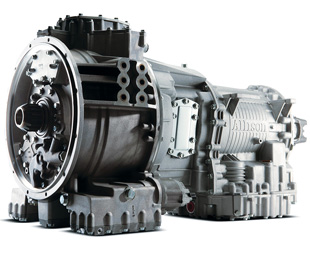Top gear

Transmission systems should present original equipment manufacturers (OEMs) with solutions to enhance fuel savings, cut maintenance costs and improve efficiency. CLAIRE RENCKEN speaks to specialists in the field that are succeeding in doing just that
The introduction of automated manual transmission (AMT) technology in the market has enabled vehicle owners to enjoy the benefits of precise shifting, optimised clutch engagements and a reduction in driver fatigue. The driver’s full attention can be focused on negotiating the road, without having to concentrate on selecting the appropriate gear for the inclines and declines.
Pieter Potgieter, marketing manager at ZF Services South Africa, says the ZF AS Tronic has enjoyed huge success globally, with well over 500 000 transmissions sold. “This technology has proven successful worldwide, but particularly in South Africa, where the driving conditions are more difficult, due to typography, and where we have larger maximum legal loads.
AMT eliminates the risk of the driver selecting the wrong gear, resulting in fewer transmission failures due to driver error. As a result there has been significant growth of the AMT sector in the medium and heavy ranges of commercial vehicles in our country,” he explains.
“In the coming years, the focus areas for transmission design will remain on the optimisation of fuel consumption to reduce operating costs. In this area, ZF has been developing the Traxon transmission for extra-heavy vehicles, which will be the replacement for the popular AS Tronic transmission in the future.
“The new technology will allow further optimisation of gear selection through the use of global positioning system (GPS) technology. In essence, the transmissions will have ‘eyes’, using the GPS to proactively select the correct gear ratio for the incline or decline to be negotiated. Tests are currently being conducted on the new transmissions and considerable fuel savings are expected,” Potgieter adds.
When it comes to automatic transmissions, American manufacturer Allison Transmission is one of the experts. Associated Automotive Distributors (AAD) Drivetrain Systems is the Southern African distributor of the brand.
 Every Allison automatic has a patented Allison torque converter designed and built specifically to meet the demanding needs of the commercial trucking industry. Automated manual transmissions have no torque converter. Instead, they have a mechanical clutch that is actuated by hydraulics or an electric motor. Therefore, Allison is of the opinion that an AMT’s performance is significantly reduced in terms of startability, reliability, acceleration and driver productivity.
Every Allison automatic has a patented Allison torque converter designed and built specifically to meet the demanding needs of the commercial trucking industry. Automated manual transmissions have no torque converter. Instead, they have a mechanical clutch that is actuated by hydraulics or an electric motor. Therefore, Allison is of the opinion that an AMT’s performance is significantly reduced in terms of startability, reliability, acceleration and driver productivity.
The torque converter can multiply the peak torque of the engine and transfer it to the gearbox. This fluid coupling component provides a cushioning effect to eliminate driveline shock. “Thus, a torque converter-equipped automatic transmission provides improved startability, faster acceleration and better traction and drive wheel control under all conditions,” Pierre Du Plessis, technical and service manager at AAD Drivetrain Systems, explains.
He continues: “Unlike manuals and automated manuals, there’s no lugging caused by turbo lag or jerking caused by harsh clutch engagement. You can think of the Allison torque converter as an infinitely variable first gear, giving you superior power, traction, control and acceleration right from the start. The Allison torque converter uses the full torque from the engine and multiplies it. Factor in the first gear ratio and rear axle ratio, and an Allison automatic delivers far more wheel power at launch.
“Manual and automated manuals must launch near engine idle speed in order to avoid damaging the clutch. This prevents the engine from spooling up the turbo and developing peak torque. The startability advantage that the Allison torque converter provides may allow you to use a lower numeric rear axle. This will let your vehicle cruise at lower engine speeds for better fuel economy, while having the same or better startability.”
Allison claims that its new transmission technology, TC10, which is a dual-purpose transmission for city and highway applications, has returned five percent better fuel economy over manuals and AMTs.
Du Plessis elaborates: “Poised to revolutionise the American Class-8 freight market, Allison’s TC10 uses innovative engineering to produce a fully automatic transmission that combines superb start-up power with the cruising fuel economy inherent in twin-countershaft technology. As the only technological solution of its kind, TC10 provides the benefits of Allison’s proprietary Continuous Power Technology to deliver uninterrupted power via clutch-to-clutch shifts, to the road tractor market. This eliminates the loss of turbo boost commonly associated with manual and AMT transmissions during gear shifts, to present a new alternative to traditional automated manual and manual transmissions.”
Across the United States, 100 major fleets have been testing the TC10, and have reported an average five percent improvement in fuel economy compared with the existing manuals and AMTs in their fleets. This reduction in fuel consumption can deliver significant financial savings for operators running fleets of road tractors in cities and on highways.
To achieve such cost-reducing results, while driving operational efficiency, the TC10 features a torque converter, twin countershaft gearbox and a blended architecture with full power shifts. This allows for seamless shifting through the gears, facilitating smooth operation, fuel economy and acceleration for distribution applications where a tractor-trailer splits its work between city and highway conditions.
Allison also boasts an adaptable hybrid system, which combines robust transmissions with fuel saving technology. As fuel savings and emission reductions are becoming more important in the commercial vehicle sector, Allison has developed the H 3000 fully automatic, parallel hybrid system for medium and heavy-duty trucks. Building upon the proven 3000 series, Allison has combined the fully automatic transmission with hybrid components. This results in a hybrid system that is designed to deliver up to 25 percent fuel savings, in a variety of commercial vehicle applications.
The H 3000 features several main components: a torque converter, motor-generator and modular lithium-ion battery packs – all of which work together to deliver exceptional fuel efficiency.
Let’s not forget, however, that the trusty manual still has a place in the market too.
Gert Agenbag, product planning and development manager at Hino South Africa, points out that manual transmissions remain the most popular and the most affordable systems worldwide and still offer the best fuel consumption. “They are also easy and affordable to repair and their parts are freely available. Furthermore, they remain very reliable with proven technology that has been around for many years.”
He adds that for certain applications, such as “tip and mix” vehicles used in construction, manual transmissions are still the only practical option. “It is also a highly competitive sector, as there are many makes and models available.”
So when selecting a transmission, it all comes down to what the vehicle will be used
for.
Published by
Focus on Transport
focusmagsa





 FUSO: Driving the Future of Mobile Healthc
FUSO: Driving the Future of Mobile Healthc



 New Electric Van Range Unveiled!
New Electric Van Range Unveiled!  A brand
A brand




 Wondering about the maximum legal load for a
Wondering about the maximum legal load for a 
 The MAN hTGX powered by a hydrogen combus
The MAN hTGX powered by a hydrogen combus


 Exciting News for South African Operators
Exciting News for South African Operators






